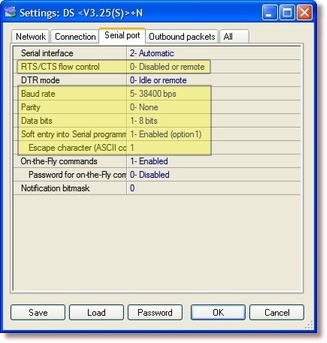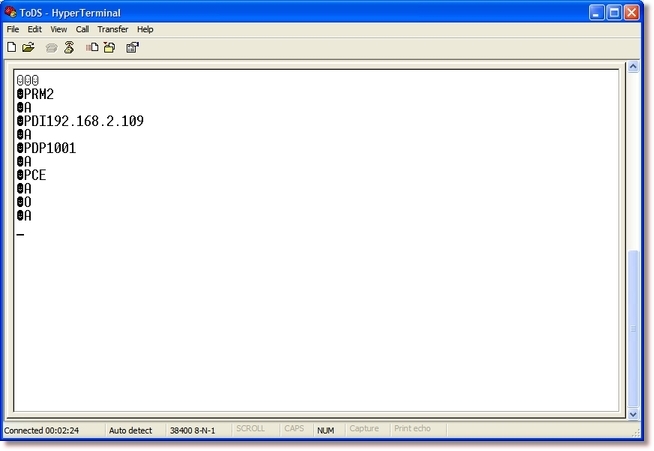Modem commands are used to control the DS from the serial side. If your serial device is 'smart', it could change the destination address or port, or establish a connection, etc, from the serial side.
| • | Run DS Manager and open the settings dialog for the DS to which you wish to connect, and switch to the 'Serial Port' tab: |

| • | Take note of the following settings: |
| • | RTS/CTS flow control: Set it to Disabled or Remote. (A complete explanation can be found here.) |
| • | Baud rate, Parity, Data bits: Can be anything, but note down what they are. |
| • | Soft entry into Serial programming: That's the whole point of this section. Should not be 0 (Disabled). Can be set to Option 1 or Option 2 -- we later have a seperate step for each of these options. |
| • | Escape character (ASCII code): Should be set to '1'. |
| • | Click OK to close the DS settings dialog. |
| • | If you selected Option 1 for Soft entry into serial programming: Hit Ctrl-A 3 times in a row, with spaces larger than 100ms (i.e, not very very fast). |
| • | If you selected Option 2 for Soft entry into serial programming: Hit Ctrl-A just once and then type a random character (e.g, hit the r key). |
| • | The LEDs should start alternately blinking (green and red). The DS is now in programming mode! |
You can now do one of two things:
For this, switch to the Programming Exercise and perform the steps described. Here is the complete programming session of the exercise, performed using Soft Entry mode 2 :

Modem commands are different than the commands in the example session in several respects:
| • | They override the default values for the settings. |
| • | They can be sent only from the serial side. |
| • | They allow you to perform important changes without rebooting the device -- thus, they are fast. |
| • | They are temporary. On the next reboot, the previous settings are restored. |
Read more about Modem Commands under Serial Programming and Modem (Serial-Side) Parameters & Instructions .
Below is a complete programming session using modem commands, performed using Soft Entry mode 1 :

In short, what this session does:
To try the programming session yourself, remember that the white smileys represent ASCII 001 chars and are produced using Ctrl+A, and the black smileys represent ASCII 002 (STX) chars and are produced using Ctrl+B.


